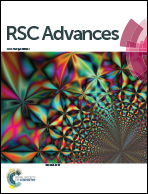Facile synthesis of copper selenides with different stoichiometric compositions and their thermoelectric performance at a low temperature range†
Abstract
Copper selenide is widely considered to be a promising candidate for high-performance flexible thermoelectrics; however, most of the reported ZT values of copper selenides are unsatisfactory at a relatively low temperature range. Herein, we utilized some wet chemical methods to synthesize a series of copper selenides. XRD, SEM and TEM characterizations revealed that CuSe, Cu3Se2 and Cu2−xSe were prepared successfully and possessed different morphologies and sizes. Based on the analysis of their thermoelectric properties, Cu2−xSe exhibited the highest Seebeck coefficient and lowest thermal conductivity among the three samples owing to its unique crystal structure. After being sintered at 400 °C under N2 atmosphere, the electrical conductivity of Cu2−xSe enhanced considerable, resulting in a significant improvement of its ZT values from 0.096 to 0.458 at 30 to 150 °C. This result is remarkable for copper selenide-based thermoelectric materials at a relatively low temperature range, indicating its brilliant potential in the field of flexible thermoelectric devices.



 Please wait while we load your content...
Please wait while we load your content...